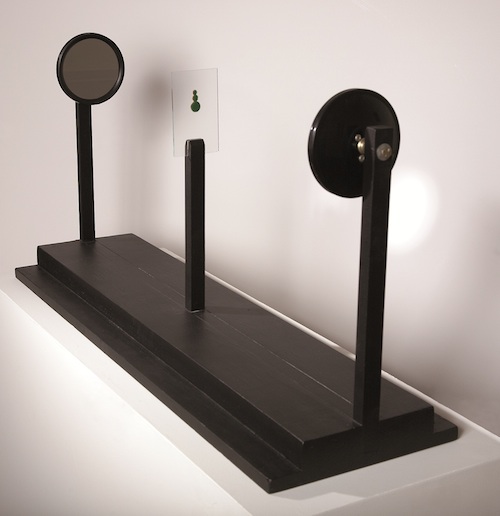Art and Architecture: Object Sculpture, 1960-1965 | Robert Morris, Julia Robinson, Jeffrey Weiss | An Artist Dialogue Series Event
Listen to audio on your iPhone or iPad
Viewing videos on NYPL.org requires Adobe Flash Player 9 or higher.
Download:
- Audio (145MB MP3, 1 hr 18 min 55 sec)
FREE - Berger Forum doors open at 5:30 p.m.
In conversation with Jeffrey Weiss and Julia Robinson, artist Robert Morris discusses various aspects of his practice, with an emphasis on the circumstances of art-making in New York during the 1960s and the themes – time, memory, language, medium, and process – addressed by his work at that time. This exchange coincides with the publication of Robert Morris: Object Sculptures, 1960-1965 (Casetlli Gallery and Yale University Press), a systematic catalogue by Jeffrey Weiss (with Clare Davies), prepared in close collaboration with the artist and his gallery.

Over the past half-century, American artist and writer Robert Morris has been a key figure in the history of minimal, post-minimal, and conceptual art. Between 1960 and 1965, part of his artistic output included approximately 100 “object sculptures” or, as Morris called them at the time, “process type objects.” These consist of plaques, containers, and assisted or simulated readymades of wood, Sculpmetal, and lead.
Robert Morris: Object Sculptures, 1960-1965 is the first study to address the object sculptures as a full and complex yet coherent body of work. Jeffrey Weiss, an authority on modernist and postwar sculpture, in close collaboration with Morris, systematically catalogues the object sculptures, and subjects them to critical and historical interpretation in the context of Morris’s early practice overall. Featuring new photography of many of the works and an interview with the artist, this book offers an important and original perspective on a crucial early period in the career of one of America’s most important artists.
Copies of the book are available for purchase and signing at the event after audience Q&A.

American artist and writer Robert Morris was born in Kansas City, MO, in 1931. Best known as one of the most significant theorists of minimalism and early practitioner of performance art, and land art, he studied engineering at the University of Kansas. Later, in Oregon, he devoted himself to the study of philosophy and psychology. In 1959 he moved to San Francisco, where he was engaged in improvisational theater and dance. In 1960 Morris moved to New York. Here he met John Cage, Marcel Duchamp, Jasper Johns, La Monte Young. In New York, Morris created his first large-scale sculptures, and played a central role in the creation of the Minimal Art movement, which emerged in the early sixties around the Green Gallery. In 1967 Morris created his first “Felt” pieces, which were exhibited at the Leo Castelli Gallery in 1968. In Artforum, he published the essay Anti Form. The work of this period, like Untitled (Scatter Piece), reflects an interest in exploring the concept of “indeterminacy” in connection to the practice of art. This interest is also reflected in the use of non-rigid materials, like Steam. In 1969 the Corcoran Gallery organized a retrospective of Robert Morris, which traveled to the Detroit Institute of Art and the Whitney Museum of American Art in New York. A subsequent retrospective was held at Tate in London in 1971. 1n 1994 the Guggenheim Museum in New York hosted a large retrospective, which traveled to the Centre Pompidou in Paris.
Works by Robert Morris are included in major museums’ collections worldwide. Among them The Museum of Modern Art, New York; The Art Institute, Chicago; the National Gallery of Art, Washington; the Centre Pompidou, Paris; Tate Modern, London. Morris currently lives and works in New York.
Jeffrey Weiss is a Senior Curator at the Guggenheim Museum in New York where he is co-running a Mellon Foundation study project devoted to the museum’s Panza Collection, a large holding of Minimal and Post-Minimal art. From 2000 to 2007, Weiss was Curator and Head of Modern and Contemporary Art at the National Gallery of Art in Washington, D.C. In 2007-08, he briefly served as Director of the Dia Art Foundation, but left to return to academic and curatorial work. Since that time he has been Adjunct Professor of Fine Art at the Institute of Fine Arts, New York, from which he also holds a Ph.D. Widely published in various periodicals on modern and postwar art, Weiss is a frequent contributor to Artforum. He is currently collaborating with On Kawara on a major exhibition of the artist’s work at the Guggenheim Museum in 2015.
Julia Robinson is Assistant Professor in the Department of Art History at New York University. In 2013 she co-curated the exhibition ±I96I: Founding the Expanded Arts at the Museo Nacional Centro de Arte Reina Sofia, Madrid. She edited the October Files volume, John Cage (October/MIT Press, 2011) and curated the 2010 exhibition "John Cage & Experimental Art: The Anarchy of Silence" organized by the Museu d’Art Contemporani de Barcelona (MACBA). She is currently completing a monograph on the artist George Brecht (forthcoming 2014).
Initiated and organized by Arezoo Moseni in 2004, Artist Dialogues Series provide an open forum for understanding and appreciation of contemporary art. Artists are paired with critics, curators, gallerists, writers or other artists to converse about art and the potential of exploring new ideas.
- Post a Comment